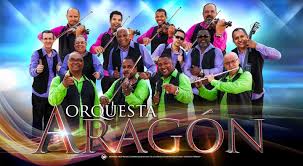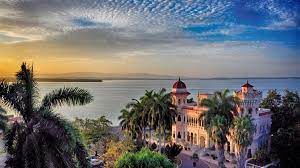LA ORQUESTA ARAGON REPRESENTANTE GENUINO DEL SON CUBANO, EL DANZON Y EL CHA CHA CHA. PHOTOS. VIDEOS
La Orquesta Aragón se ha convertido en una leyenda del son cubano con más de 80 años de trayectoria. Han sido reconocidos mundialmente y han recibido cinco Latin Grammy.
LA ORQUESTA ARAGON fue fundada en Cienfuegos, en 1939, por el destacado músico Orestes Aragón. Su música tiene el sonido característico tradicional del son cubano y su principal líder fue Rafael Lay Apesteguía.
Lay nació el 17 de agosto de 1927, en una familia humilde en Cienfuegos. Mostró talento musical desde muy temprana edad. Recibió su primer violín de regalo a los nueve años, pero tuvo que interrumpir sus estudios debido a dificultades económicas.
Continuó aprendiendo su instrumento y se convirtió en el primer violín de la Orquesta Aragón a los 13 años de edad. A lo largo de su carrera, destacó como violinista, director, arreglista y compositor.
VIDEOS- LA ORQUESTA ARAGON INTERPRETA….
Su liderazgo llevó a la Orquesta Aragón a alcanzar un sonido característico que conserva hasta la actualidad y que le permitió conquistar una gran popularidad y fama mundial.
En su historial la Orquesta Aragón atesora numerosos premios, el más reciente es el Latin Grammy de mejor Álbum Tropical Tradicional con el disco Cha Cha Chá: Homenaje a lo tradicional, en 2021.
Rafael Lay dejó un legado musical significativo en la Cultura Cubana, siendo reconocido por sus arreglos y composiciones, como los famosos boleros “Nosotros” de Pedro Junco y “Noche azul” de Ernesto Lecuona.
Además de su trabajo con la Orquesta Aragón, Lay también dirigió otras agrupaciones y brindó asesoramiento a diversos grupos y orquestas. Falleció en un accidente automovilístico el 13 de agosto de 1982 en la carretera Trinidad-Cienfuegos, dejando un legado perdurable en la música cubana.
HACIENDO HISTORIA DE LA ARAGON
A lo largo de más de ochenta años han pasado por la nómina de esta importante agrupación figuras de la música cubana como Benny Moré, Dámaso Pérez Prado y Félix Chapotín.
Los tres directores de la agrupación han sido: el fundador, Orestes Aragón Quintero, el sucesor, Rafael Lay y su hijo Rafelito Lay Bravo. Han creado un sonido propio, un estilo único y han sabido respetar la tradición y mantenerse fiel a ese sonido durante décadas.
La Orquesta Aragón se ha presentado en importantes escenarios internacionales como en el Lincoln Center de Nueva York; en el Conservatorio Chaikovsky, de Moscú; en el Olympia, de París; y en la Expo ’70, celebrada en Osaka, Japón, entre muchos otros.
Han realizado giras por Japón, Estados Unidos, Francia, España, Alemania, Colombia, México, Chile, Unión Soviética, Venezuela, Egipto, Guatemala y Angola, entre más de veinte países.
La agrupación mantiene su formato charanguero con 14 músicos en escena, cuatro violines, güiros, timbales, piano y voces.
Los directores han mantenido una premisa de trabajo de equipo. La orquesta es una suma de talentos y creaciones con un objetivo común “que la Orquesta Aragón sea la que brille”.
Es una agrupación con tres generaciones sucesivas de músicos, más de 700 temas grabados y alrededor de cien discos.
Quien escucha a la Aragón recuerda el sonido inimitable de sus violines y su flauta.
La UNESCO declaró a la Orquesta Aragón como Patrimonio Inmaterial de La Humanidad en 2005.
El sonido Aragón forma parte del imaginario colectivo de los cubanos. Se asoció durante décadas, a Radio Progreso y al popular espacio Alegrías de sobremesa, ya desaparecido.
El repertorio de la Orquesta Aragón incluye canciones tradicionales cubanas como El bodeguero, Nosotros, Cachita, Pare cochero, Son de la loma, Guajira con tumbao, Yo no bailo con Juana, Calculadora, Si sabes bailar mi son y El paso de Encarnación, entre muchos otros.
THE ARAGON ORCHESTRA, A GENUINE REPRESENTATIVE OF THE CUBAN SON, THE DANZON AND THE CHA CHA CHA. PHOTOS
The Aragón Orchestra has become a legend of the Cuban son with more than 80 years of experience. They have been recognized worldwide and have received five Latin Grammys.
THE ORQUESTA ARAGON was founded in Cienfuegos, in 1939, by the prominent musician Orestes Aragón. Their music has the traditional characteristic sound of the Cuban son and their main leader was Rafael Lay Apesteguía.
Lay was born on August 17, 1927, into a humble family in Cienfuegos. He displayed musical talent from a very early age. He received his first violin as a gift from him at the age of nine, but had to interrupt his studies due to financial difficulties.
He continued to learn the instrument from him and became first violin in the Orquesta Aragón at 13 years of age. Throughout his career, he excelled as a violinist, conductor, arranger, and composer.
His leadership led the Orquesta Aragón to achieve a characteristic sound that it preserves to this day and which allowed it to achieve great popularity and worldwide fame.
In its history, the Orquesta Aragón has received numerous awards, the most recent being the Latin Grammy for Best Traditional Tropical Album with the album Cha Cha Chá: Homenaje a lo tradicional, in 2021.
Rafael Lay left a significant musical legacy in Cuban Culture, being recognized for his arrangements and compositions, such as the famous boleros “Nosotros” by Pedro Junco and “Noche azul” by Ernesto Lecuona.
In addition to his work with the Aragón Orchestra, Lay also directed other groups and provided advice to various groups and orchestras. He died in a car accident on August 13, 1982 on the Trinidad-Cienfuegos highway, leaving a lasting legacy in Cuban music.
MAKING THE ARAGON HISTORY
Throughout more than eighty years, figures of Cuban music such as Benny Moré, Dámaso Pérez Prado and Félix Chapotín have passed through the payroll of this important group.
The three directors of the group have been: the founder, Orestes Aragón Quintero, the successor, Rafael Lay and his son Rafelito Lay Bravo. They have created their own sound, a unique style and have known how to respect tradition and stay true to that sound for decades.
The Aragón Orchestra has performed on important international stages such as the Lincoln Center in New York; at the Tchaikovsky Conservatory, in Moscow; at the Olympia, in Paris; and at Expo ’70, held in Osaka, Japan, among many others.
They have toured Japan, the United States, France, Spain, Germany, Colombia, Mexico, Chile, the Soviet Union, Venezuela, Egypt, Guatemala and Angola, among more than twenty countries.
The group maintains its charanguero format with 14 musicians on stage, four violins, güiros, timbales, piano and voices.
The directors have maintained a premise of teamwork. The orchestra is a sum of talents and creations with a common objective “that the Aragón Orchestra be the one that shines”.
It is a group with three successive generations of musicians, more than 700 recorded songs and around one hundred records.
Anyone who listens to Aragón remembers the inimitable sound of her violins and flute.
UNESCO declared the Aragon Orchestra as Intangible Heritage of Humanity in 2005.
The Aragón sound is part of the collective imagination of Cubans. It was associated for decades with Radio Progreso and the popular Alegrías desktop space, now defunct.
The Orquesta Aragón repertoire includes traditional Cuban songs such as El bodeguero, Nosotros, Cachita, Pare cochero, Son de la loma, Guajira con tumbao, Yo no bailo con Juana, Calculator, If you know how to dance my son and El paso de Encarnación, among much others.
Agencies/ Wiki/ CiberCuba/ AragonOrq./ Extractos/ Excerpts/ Internet Photos/ YouTube/ Arnoldo Varona/ www.TheCubanHistory.com
THE CUBAN HISTORY, HOLLYWOOD.



 THE ARAGÓN Orchestra, Genuine Representative of Cuban Son, the Danzón and Cha Cha Cha. PHOTOS. VIDEOS. * LA ORQUESTA ARAGÓN, Genuino Representante del Son Cubano, el Danzón y el Cha Cha Cha. PHOTOS. VIDEOS.
THE ARAGÓN Orchestra, Genuine Representative of Cuban Son, the Danzón and Cha Cha Cha. PHOTOS. VIDEOS. * LA ORQUESTA ARAGÓN, Genuino Representante del Son Cubano, el Danzón y el Cha Cha Cha. PHOTOS. VIDEOS.






